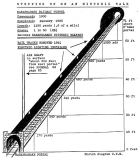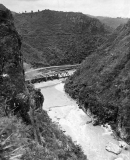Ohinemuri Regional History Journal 30, September 1986
A UNIQUE NEW ZEALAND WALKWAY
By C W Malcolm
On Sunday 23 February, a comfortable bus load of members of the Paeroa Old Pupils' Association (Auckland) journeyed to historic Karangahake. Across the double-deck bridge, the hall provided the facilities for lunch and for the viewing of a display of excellent enlarged photographs of the town in its vigorous mining days. The bus conveyed the visitors up the old Rahu Road and later, some distance up the mountain road to view, not only the magnificent scenery, but also the astonishing number of fine residential dwellings of the unexpectedly numerous inhabitants that have brought about something of a renaissance in this spot where the collapse of the gold-mining boom had caused a sad decline.
The brilliant conception of the Walkway was regarded by the visitors, especially those who once lived in Karangahake or knew it well, as an amazing achievement. Some moved off towards the Waitawheta Gorge while others, including the writer, headed for the rare experience of walking through that once notorious railway tunnel. As children, in the days before Paeroa possessed a manual school, we journeyed by rail, through that three-quarter mile tunnel to Waihi tech for woodwork and cookery classes. At other times, for the same purpose, we were taken to Thames and to Te Aroha. What terrible boring rail journeys these were compared with the exciting trip by river and mountain, through tunnel and gorge, round squealing curves and past foaming waterfalls to Waihi!
But oh! that tunnel! 1190 yards in length, with a rise of two feet in every hundred feet travelled! When we emerged from the Waikino end of the tunnel we were 71.4 feet higher than when we entered it at the Karangahake end! No wonder the trains made it a panting, laborious climb, filling the passenger carriages with suffocating sulphurous fumes from the blast of the steam locomotive's exhaust beating against the roof in the confined space of the tunnel. It was even worse when the guard had not bothered to turn on the carriage lights and we proceeded in frightening Stygian darkness that could be almost felt. No wonder that driver and fireman were known to wrap cloth across their faces and crouch on the floor of the cab letting their engine "have her Head" after as fast a dash from Karangahake Station as possible, into the mouth of the tunnel.
Some 600 feet in from the Karangahake portal a large air shaft pierced its way far upwards to the surface. Visitors told of their childhood days when they actually played about the surface of the shaft and how, on at least one occasion, boys dropped a large boulder listening for its fall on the tunnel floor at the bottom of the long shaft. Vandalism? No doubt the fascination that has caused many of us to drop stones into old wells or mine shafts for the same innocent purpose. Fortunately a surfaceman on a jigger always preceded trains over his section of the track.
Sketch: STEPPING UP ON AN HISTORIC WALK [see below]
KARANGAHAKE RAILWAY TUNNEL
Commenced: 1900
Completed: January 1905
Length: 1190 yards (0.6 of a mile)
Grade: 1 in 50 (2%)
Becomes KARANGAHAKE HISTORIC WALKWAY
RAIL TRACKS REMOVED 1981
ELECTRIC LIGHTING INSTALLED
Air Shaft to surface "about 600 feet from west portal" see JOURNAL 23 page 23 [see Journal 23: Paeroa-Waihi Railway 1897-1978 - E]
To walk through that tunnel with its upward climb and with the engine-driver's view of the distant portal - the light at the end of the tunnel - ahead, was a fascinating experience. The soot crusted walls were damp with moisture and drops fell from the arch of the roof making puddles on the path or collecting to flow swiftly downward in the channels on either side ultimately to reach the clear Ohinemuri River as it changed from reflecting pools to scintillating stretches over pebbly shallows - so different from the days when it was polluted as a designated sludge channel discoloured by the tailings from the mining batteries and poisoned by cyanide. It was difficult to imagine the tunnel and the Walkway as part of the old picturesque Paeroa - Waihi railway line. There is something sad about an abandoned railway. One sees them all over England, the rails and sleepers gone, all that remains a grass-grown track. The steel rails have a permanence about them, a fixed regularity, known as "the permanent way" they presage the thunder of the trains that will be guided over them. When they are gone we are left with an uneven track and a hole through the mountain.
The pedestrian through that hole, now fortunately lit by a well-spaced series of electric lights, wonders at the efforts of those men who, with pick and shovel, dug it out of the mountain.
The "Auckland Weekly News" of 13 July 1900 reports that the people of Karangahake wished the line to go through the town and not through a tunnel but that the Railways Department insisted on the tunnel being driven. A temporary bridge from the Karangahake portal conveyed the spoil dug from the tunnel towards Mackaytown for the roadbed of the railway to Paeroa. Elsewhere one reads that "heavy ground and copious water slowed up the progress" and though trains ran from Paeroa to Karangahake in 1904, the completed bricked tunnel saw the first goods trains through from April 1905. The official opening was on 9 November 1905, when Paeroa and Waihi were linked by passenger rail service.
A diagram attached shows a "track profile" understood by railway engineers but appearing out of proportion to the layman. However it indicates where the railway track climbs or descends or runs on the level and indicates the grades that exist between Paeroa and Waihi. The walk through the tunnel has its reward for the breath taking view of road, river and precipitous cliffs seen from the bridge spanning the rapids at its upper portal.



